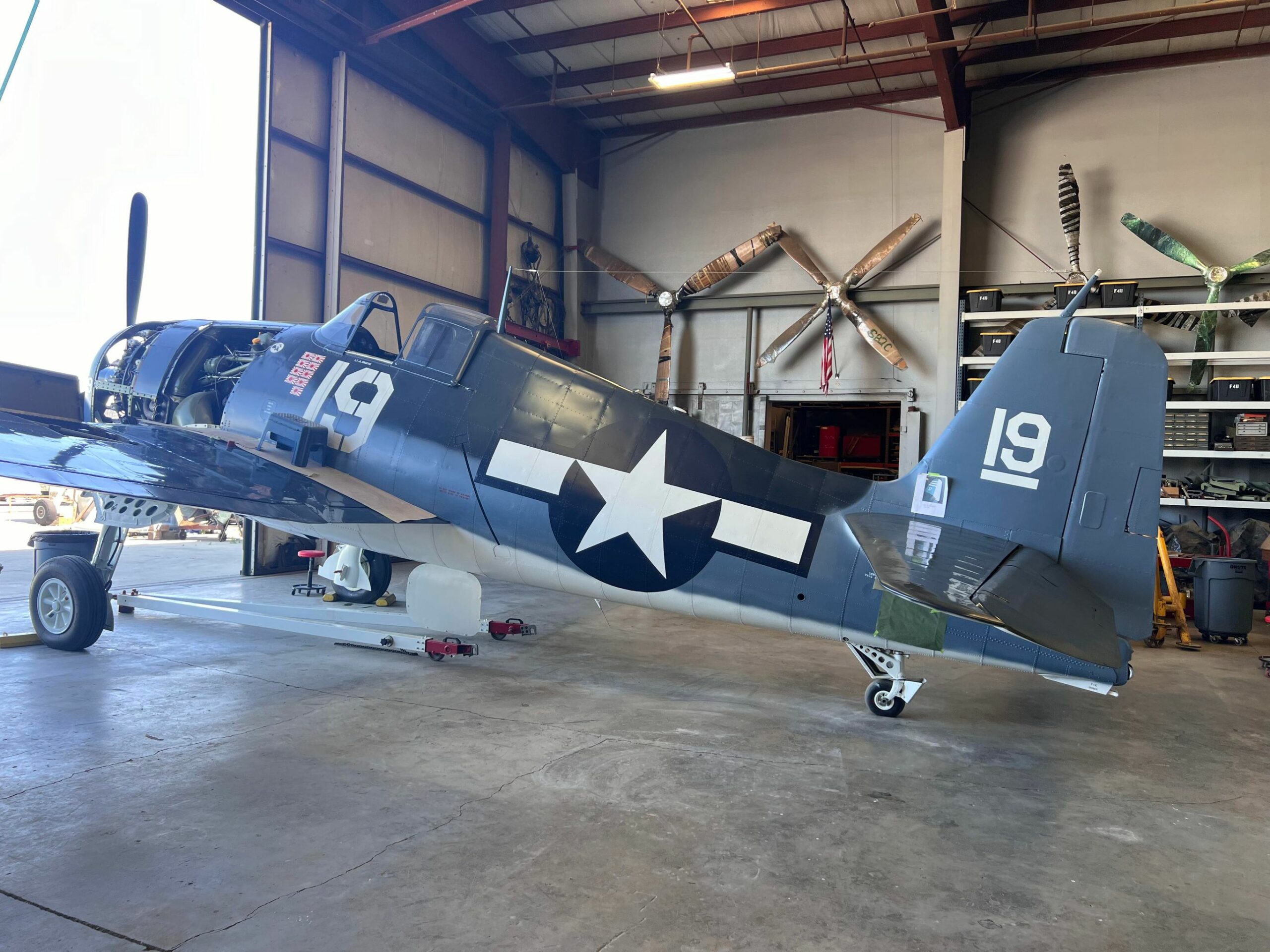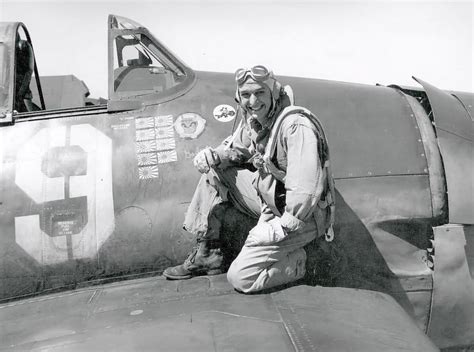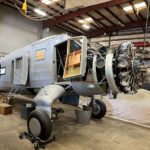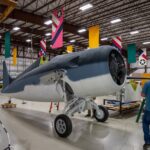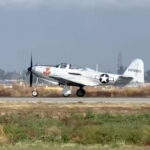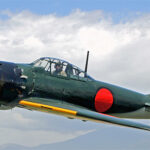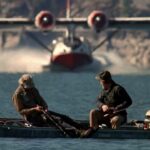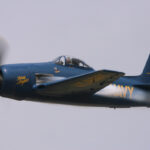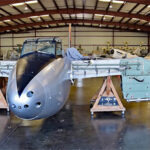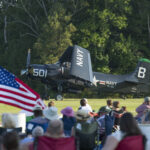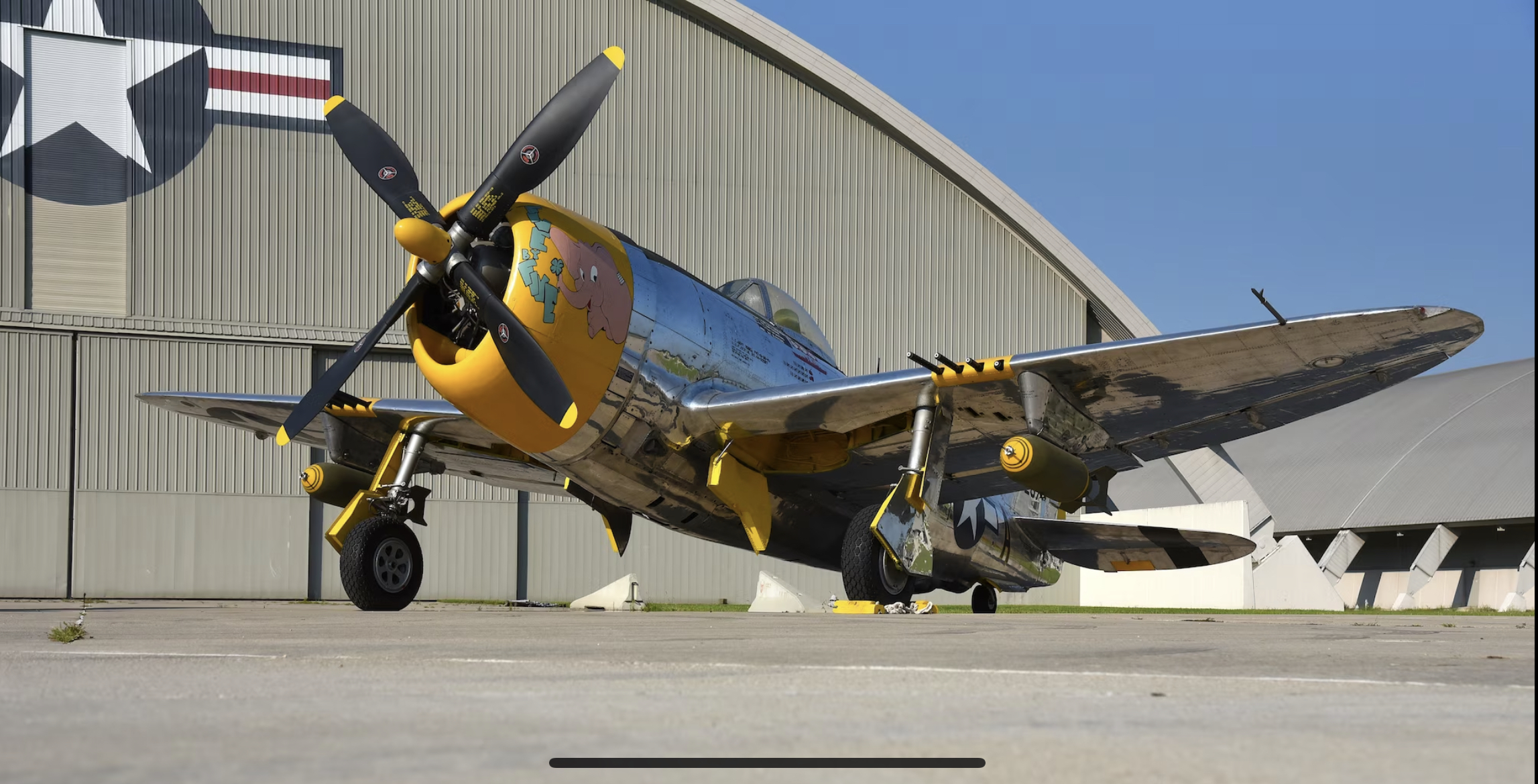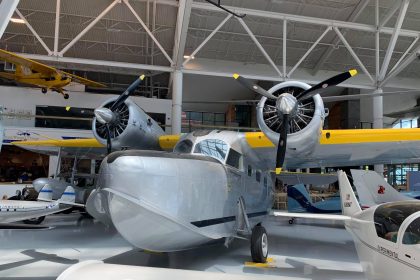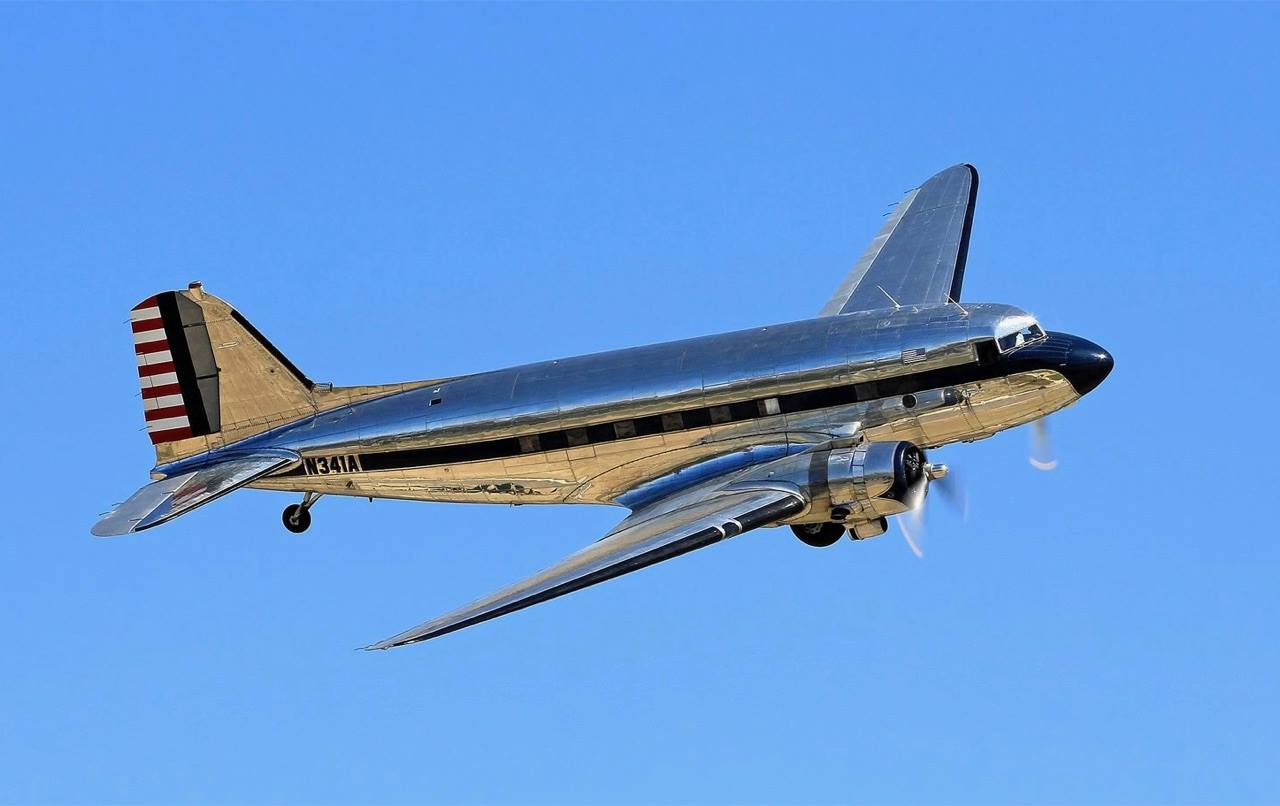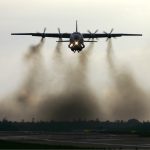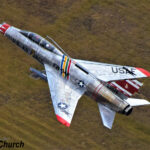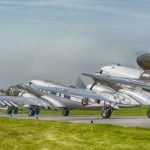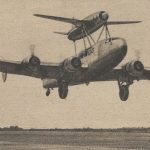By Adam Estes
The Grumman F6F Hellcat was one of the most effective carrier-based fighters of World War II, with an incredible 19:1 kill ratio and was the mount of the U.S. Navy’s highest scoring aces, such as David McCampbell and Alexander Vraciu. However relatively few of the more than 12,000 Hellcats built survived the postwar disposal of surplus aircraft, with some even being used as remote-controlled target drones, and fewer still remain airworthy. A few of those survivors, though, can owe their continued existence in part to the efforts of the Yanks Air Museum in Chino, CA which is now in the home stretch of restoring another of these aircraft back to the skies.
The current project at Yanks Air Museum is comprised of several Hellcats to make a complete aircraft, so retracing the provenance of the project before its time at Yanks has been somewhat complicated, but what is certain is that the two most prominent Hellcats used in the restoration of this aircraft are F6F-3 Bureau Number (BuNo.) 08831 and F6F-3 BuNo 40467.
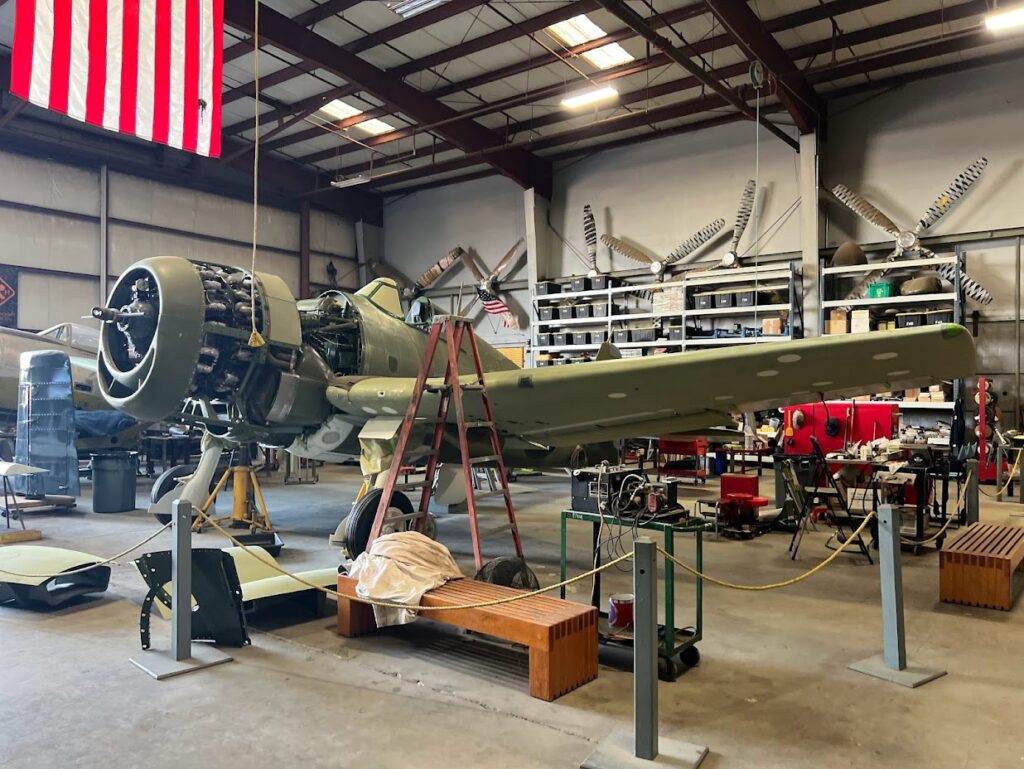
According to the Individual Aircraft Record Cards (IARCs) provided by the National Naval Aviation Museum in Pensacola, FL, F6F-3 08831 (Manufacturer’s number A-218) was delivered to the US Navy from the Grumman plant in Bethpage, LI, on April 25, 1943 at Naval Air Station (NAS) New York (originally Brooklyn’s Floyd Bennett Field, which is now part of the Gateway National Recreation Area as managed by the National Parks Service). Three days later, 08331 was transferred to NAS Memphis, TN where it would take part in miscellaneous duties on the base until its short service life came to an end on June 14th, 1944, when it was officially stricken from the Navy’s inventory. In contrast, F6F-3 40467 would lead a more eventful service life. Like 08831, 40467 was built in the Grumman “Iron Works” factory in Bethpage as c/n A-1733 and delivered to the USN at NAS New York on November 5, 1943. Soon afterwards, it was ferried across the country to San Diego on November 17th, before flying further north to NAS Alameda the following day.
The record cards from Pensacola do not go into further details until the end of its naval service but aviation historian Richard M. Hill, who would write the article Hellcat 40467: The History of One F6F for the Fall 1972 issue of the American Aviation Historical Society (AAHS) journal, fills in the story using 40467’s logbook. According to Hill, 40467 was shipped from Alameda to Pearl Harbor, HI, where a fateful connection would be forged between 40467 and one of the U.S. Navy’s most successful aces of the Pacific War, Alexander Vraciu.
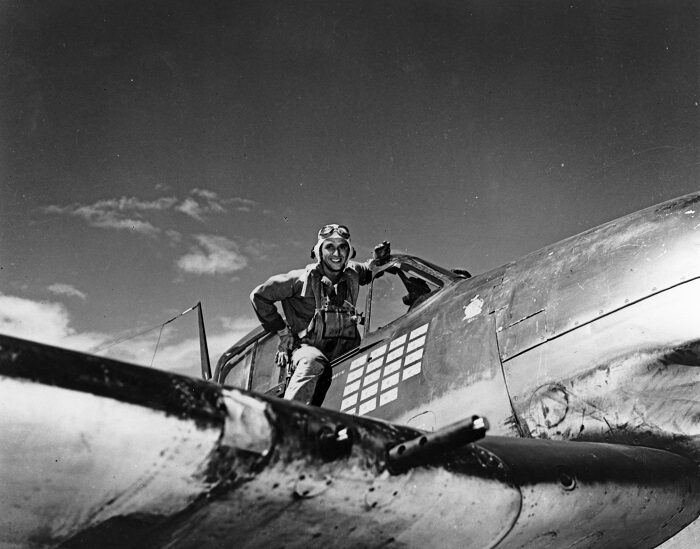
Known to history as the USN’s fourth-highest ranking ace of WWII, Alexander Vraciu was born in 1918 in East Chicago, ID as the son of Romanian immigrants from Transylvania. After graduating from DePauw University, where he earned his private pilot’s license through the US government-sponsored Civilian Pilot Training Program (CPTP), Vraciu enlisted in the U.S. Navy on October 9th, 1941, in order to earn the Golden Wings of a naval aviator. After completing his training (where as a cadet he once attended a speech made by Medal of Honor recipient and Navy ace Lieutenant Commander Edward “Butch” O’Hare at Corpus Christi, TX), he was sent to Hawaii to join VF-3, then commanded by Butch O’Hare himself, who made Vraciu his wingman and gave the young aviator valuable advice that would serve him well. By then, however, the squadron had swapped its designation with VF-6, and was split into several detachments serving aboard the light carriers USS Independence (CVL-22), USS Belleau Wood (CVL-24), and USS Cowpens (CVL-25). Vraciu was assigned to the Independence detachment. There he would have his baptism by fire over Wake Island, scoring his first aerial victory on October 5th, 1943 against a Mitsubishi A6M Zero, and his second victory on November 20th against a Mitsubishi G4M Betty bomber. However, later that night, Independence was struck by an air-launched torpedo during a Japanese counterattack and after emergency repairs in Funafuti, Tuvalu, the ship would stopover in Pearl Harbor to drop out its aviators before setting out for the shipyards of San Francisco for permanent repairs. But as the Independence was in transit for Pearl Harbor, the detachment of VF-6 aboard USS Independence learned the terrible news that on the night of November 26th, 1943, Lt. Cmdr. Butch O’Hare was reported as missing in action after having attempted to intercept a flight of “Betty” bombers while flying from the carrier USS Enterprise (CV-6) near the Gilbert Islands. Despite a thorough search, neither Butch O’Hare nor his aircraft were ever discovered. Vraciu vowed to his wingman Willie Callan that he intended to shoot down 10 Bettys in retaliation. But in the meantime, he and the rest of VF-6 would fly practice flights out of the eastern side of Oahu NAS Kaneohe Bay (now Marine Corps Base Hawaii), along with the other pilots of VF-6 who had returned from their own detachments aboard Belleau Wood and Cowpens.
While practicing in Hawaii, VF-6 would take delivery of several new Hellcats. On December 17, they added BuNo 40467 to their squadron, and the aircraft was assigned to Alex Vraciu. The aircraft had only 20.5 flight hours logged, but with Vraciu, man and machine would record a further 21.5 hours in the skies above Hawaii. Before that, though, on December 20th, the squadron had moved from NAS Kaneohe Bay to NAS Barbers Point, on the southwestern corner of Oahu. That same day, 40467 was given the squadron code 19, which was applied in block letters to the engine cowling, landing gear covers, fuselage sides, and the vertical stabilizer, where it was underlined with a white bar. On January 10th, 1944, the new Essex-class fleet carrier USS Intrepid (CV-11) steamed into Pearl Harbor, stopping by on its westward voyage, and would add VF-6 to its air wing. From January 12-14, VF-6 would conduct qualification trials aboard USS Intrepid, with Vraciu making both a day and night landing on the 12th, and a third landing on the 13th.
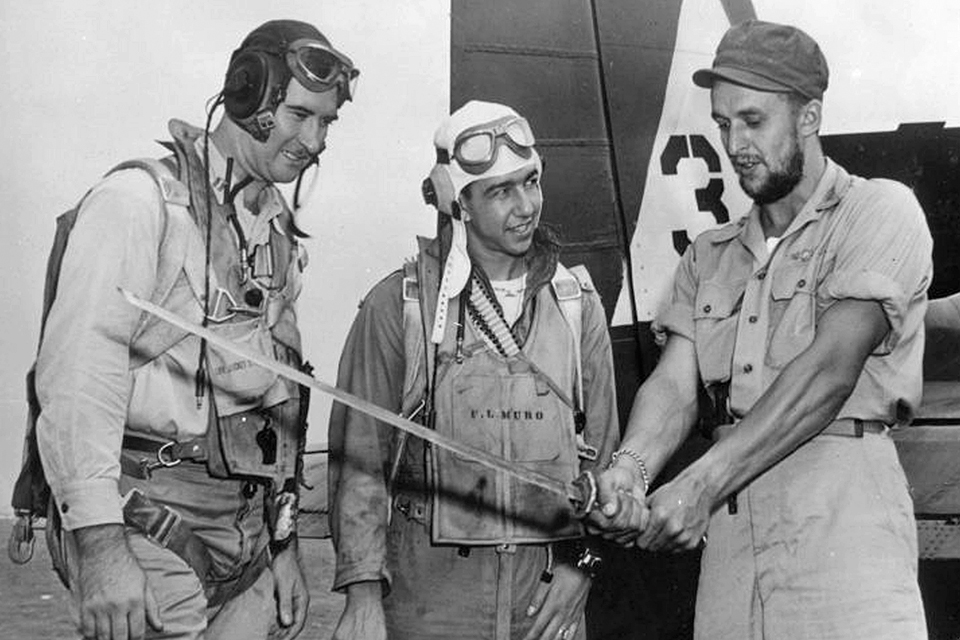
Finally, on January 16th, Intrepid slipped her moorings and set to sea to join Task Force 58 alongside USS Essex (CV-9) and USS Cabot (CVL-28). On January 29th, while flying 40467, Vraciu shot down three Bettys over Kwajalein Atoll, becoming an official ace. During this action, Vraciu even managed to force the final Betty down after all but one of his six guns had jammed. From February 1-3, Vraciu and 40467 set off on Combat Air Patrols (CAPs) over Kwajalein, but these flights were not as fruitful given the new-found lack of Japanese air opposition. By February 14th, though, Task Force 58 had set their sights on Truk Atoll (now called Chuuk Lagoon), a major Japanese stronghold in the central Pacific in what is now Micronesia. This air offensive, codenamed Operation Hailstone, sought to destroy air and surface targets at Truk to weaken the Japanese offensive capabilities from this vital installation.
On February 17, 1944, Lt. Jg. Vraciu took off from USS Intrepid in F6F-3 40467, joining a flight of 12 Hellcats from VF-6, which were among a total of 72 Hellcats from six carrier Air Groups on a fighter sweep mission, unencumbered by Avenger, Dauntless, and Helldiver bombers which the Hellcats would typically escort on most missions. Vraciu would recall later that in fact, he and his fellow Hellcat pilots were looking forward to this mission. By 0800 hours, Vraciu’s flight was above the airfield on Moen Island, and the flight began to dive down to make their strafing runs. But just as Vraciu and his wingman, Ensign Lou Little, who were at the tail-end of the formation and about to make their dives, Vraciu spotted a flight of A6M Zeros between 2,000 and 3,000 feet above him and Little coming from their 7 o’clock position. Vraciu called out the bandits, but with the other Hellcats already in their dives towards the airfield, it was up to Vraciu and Little to turn into the oncoming attack and face the Japanese head on. Though this caused the Japanese flight leader to break off this attack, Lt. Jg. Vraciu and Ens. Little found themselves surrounded.
To counter this, Vraciu and Little pulled their Hellcats into a steep chandelle maneuver before engaging in a Thach Weave, repeatedly turning towards and away from each other in order to clear any Zeros from each other’s tails. This caused the Zeros, who originally tried to break this maneuver by using their greater number to attack from multiple angles, to descend and engage the Hellcats at their altitude level, prompting Vraciu and Little to go from defensive to offensive tactics. Vraciu himself noted the Japanese response to this by stating, “We noticed that the Japanese pilots weren’t reluctant to attack, but once they were cornered they’d dive steeply for the water or cloud cover. The Hellcat can definitely outmaneuver the Zero at speeds of 250 knots and better, so we began to follow them down.” It was in this manner that Vraciu shot down two Zeros in a dive in quick succession, before spotting a Nakajima A6M2-N Rufe, a floatplane variant of the Zero, which he also dealt with, saying later in an interview, “Once I got on their tail, I didn’t let go.” After pulling up from this third victory of the day, Vraciu recalled, “While climbing back up for altitude after one of these attacks, I noted a Zero skirting a not-too-thick cloud so I made a pass at him. He promptly headed for a thicker one and, after playing cat-and-mouse with him for several minutes I climbed into the sun and let him think I had retired. When I came down on him for the last time, from five o’clock above, he never knew what hit him, I’m sure. His wing tank and cockpit exploded.”
After Vraciu landed 40467 back on the Intrepid’s deck another pilot, Ens. Joseph F. Moynihan, would take 40467/White 19 on a second combat sweep of the day, but did not score any additional kills. Later, on the night of February 17-18, 1944, though, a flight of six Nakajima B5N Kate torpedo bombers launched a night raid on the carriers of Task Force 58. One torpedo found its mark on USS Intrepid at 2211 hours, killing 11 sailors and wounding a further 17, causing flooding in several of the ship’s compartments and jamming the Intrepid’s rudder hard to port. Damage control teams were able to keep the ship afloat, but it was evident that the Intrepid needed to withdraw from combat for repairs. The ship’s crew were able to keep her on course for Pearl Harbor by running her portside screws (propellers) and high speed while running her starboard screws at idle. The crew also fashioned a large sail out of spare canvas and rigged the makeshift sail to the ship’s forecastle, counteracting the high winds that pushed against the ship on its return voyage. On February 24th, Intrepid sailed into Pearl Harbor, and off-loaded her complement of aircrews and aircraft as temporary repairs were made to enable the carrier to return to the Hunters Point Naval Shipyard in San Francisco for more permanent repairs, arriving on March 19th, and remaining at Hunters Point until June 1944.
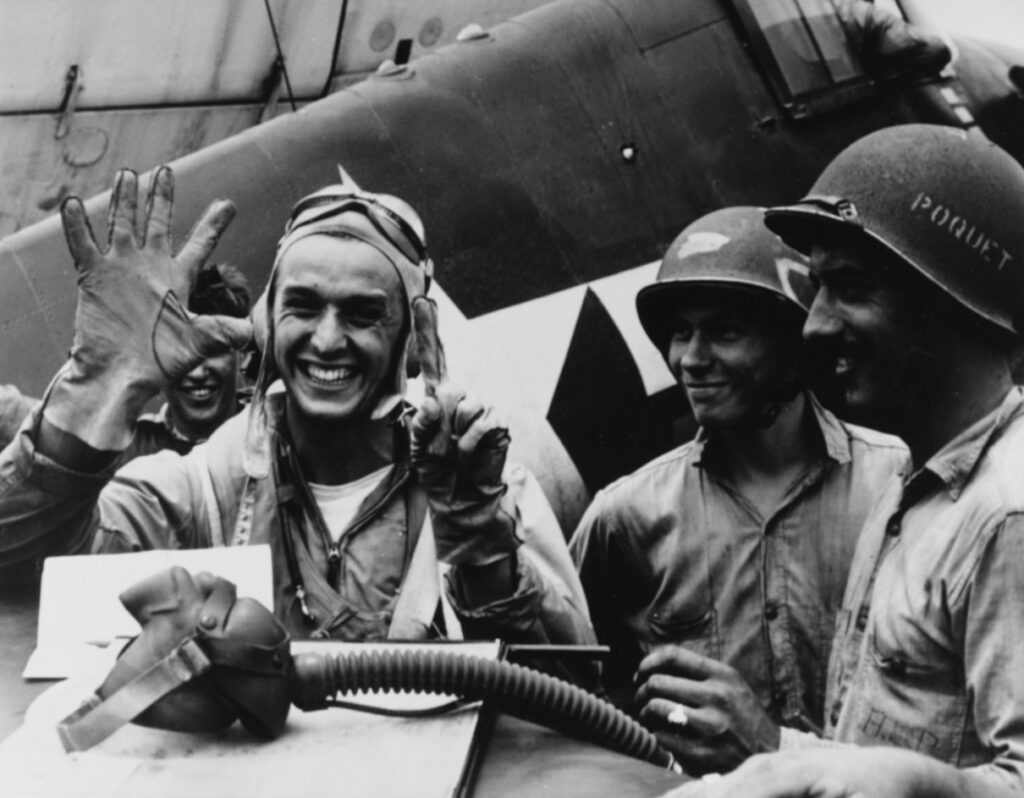
Meanwhile, the aviators of VF-6 embarked on the escort carrier USS White Plains (CVE-66) to return to Alameda. Although he had a ticket to return to the United States Alexander Vraciu, now with nine aerial victories, decided to request a transfer to another carrier squadron that would remain in the fight. With this request granted Vraciu found himself part of VF-16 aboard one of Intrepid’s sister ships, USS Lexington (CV-16), named in honor of the carrier for which Butch O’Hare was awarded his Medal of Honor by shooting down five Bettys that were on course for the ship on February 20, 1942, and which would later be lost during the Battle of the Coral Sea in May 1942. It would be from the new Lexington that Vraciu would go on to score a further ten victories during the war, including six Yokosuka D4Y Judy dive bombers shot down within the span of eight minutes during the Battle of the Philippine Sea, also known as the “Great Marianas Turkey Shoot”, earning him the Navy Cross, though he was originally nominated to receive the Medal of Honor. The image of a proud Vraciu holding up six outstretched fingers to show his tally for the day shortly after returning to the USS Lexington has gone on to become one of the most iconic photos of WWII.
As for F6F-3 BuNo 40467, the aircraft was transferred back in February 1944 to VF-18, which had originally been scheduled to fly off the USS Intrepid, but with the crippled carrier under repair, they would have their pre-scheduled training at Hilo, on the main island of Hawaii, extended. This flight training for VF-18 would also take place at Kaneohe Bay, with the pilots conducting gunnery, bombing, and tactical missions until June of 1944. However, although Richard Hill noted that the logbook of 40467 reported that it conducted carrier landing practice on June 2nd, the aircraft would not return to combat, but would instead be shipped back to Alameda with only 318 hours worth of flight time logged. No explanation would be presented for this but, regardless, 40467 was en route for Alameda by June 14th and returned there on June 22nd and kept in storage.
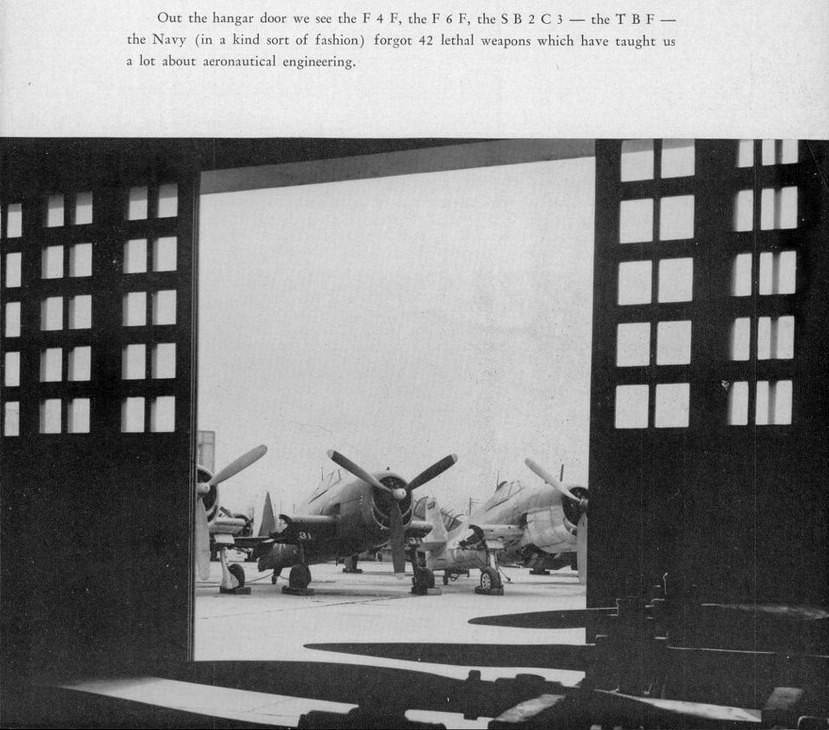
As Vraciu was nearing the end of his tour of duty with VF-16, 40467 was ordered to be disassembled at Alameda and packed up for shipment to the Naval Air Technical Training Center (NATTC) Chicago, which resided at the Chicago Vocational School (now the Chicago Vocational High School). Though originally intended to instruct the youth of Chicago’s South Side, the newly-completed facility was turned over to the Navy on June 1st, 1941, as the looming threat of war made civilian and military officials feel that the school’s facilities would be better used to instruct naval aviation mechanics and other workers involvement in the rearmament of the U.S. 40467 was shipped from Alameda on August 15, 1944, and arrived in Chicago via NAS Glenview, on August 29th. Two days later, on August 31st, it was stricken from the Navy. By this point, Vraciu had just returned home to East Chicago fresh off his victories during the Marianas Turkey Shoot, and was at this point in the war the U.S. Navy’s leading ace.
While awaiting his next deployment, he would take part in public events and rallies to promote the Navy’s wartime efforts and for the public to buy war bonds. In September 1943, a large rally was held at Wrigley Field to honor the local radar and radio industries of Chicago that had contributed much to the Allies’ ongoing war efforts. Also present at the ceremonies was Alexander Vraciu, along with Hellcat 40467, which had been hastily reassembled from its packing crates and placed at the entrance of Wrigley Field. The stencils of the nine Japanese flags representing the victories of Vraciu up to February 1944, along with his name, were still present on the cockpit section of the aircraft, and were joined by a further ten flags for Vraciu’s new total of 19 victories. But after the crowds at Wrigley Field returned to work and Vraciu went on his way back to the Pacific, 40467 returned to the NATTC facilities, joining fellow F6F-3 08831. There, the two Hellcats were used as instructional airframes alongside other surplus aircraft, and remained there when the school returned to civilian management in April of 1946. While the school would settle into the routine of offering four-year courses for teenage students, many of the school’s students immediately after the war were incoming veterans taking night courses and attempting to acquire the skills that would serve them in peace after serving their country in war. Both 08831 and 40467 would remain in the school’s workshops, used for sheet metal repair work and hydraulic system training, 08831 and 40467 were sold off by the school during the 1960s, and were acquired by one of the pioneers of aircraft preservation in the Midwest.
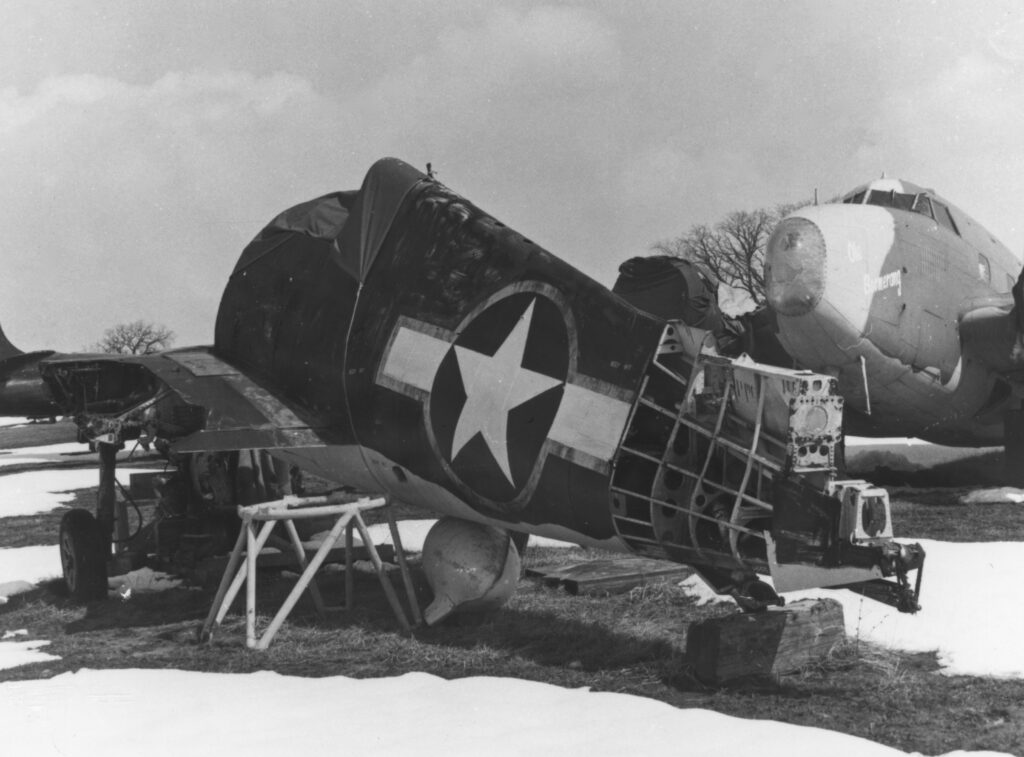
Without Earl Reinert, it is likely that the stories of Hellcats 08831 and 40467 would have ended in some scrapyard in Chicago. Originally a surplus dealer, Reinert would partner with his friend and local pilot Amilio “Paul” Polidori to create the Victory Air Museum, an open-air collection of aircraft acquired by Reinert stored at Polidori’s grass airstrip near Mundelein, Illinois, about 50 miles northwest of the Chicago Vocational High School. The aircraft displayed here included not only the now incomplete Hellcats, but also a Republic YP-47M Thunderbolt flown in the Bendix Races, a B-25J Mitchell, A-26 Invader, MXY-7 Ohka, several Hispano HA-1112 Buchons from the film Battle of Britain, and even the cockpit section of a Henschel Hs 129 WWII German ground attack aircraft. But by the late 1970s and early 1980s, the Victory Air Museum gradually began to sell off its prized collections, with the YP-47M, MXY-7 Ohka, and eventually the two incomplete Hellcats ended up in the growing collection of Charles Nichols and the Yankee Air Corps, now known as the Yanks Air Museum of Chino California.

Initially, Nichols had acquired 40467 from Reinert around 1980, while fellow Chino-based collector Edward T. Maloney, founder of the Planes of Fame Air Museum, had acquired the remains of 08831 in 1979 to provide parts for the rear fuselage of another Hellcat, former F6F-5K target drone BuNo 94473 (now part of the Palm Springs Air Museum). Once Maloney had gotten the parts he needed from 08831, Nichols acquired the remains of 08831. Even then, however, Yanks was no stranger to the F6F Hellcat. In March of 1978, Nichols acquired a complete and airworthy F6F-5K, Bureau Number 76845 (now part of the Fagen Fighters WWII Museum in Granite Falls, Minnesota), and would acquire another -5K Hellcat from fellow collector Thomas “Tom” Friedkin, Bureau Number 80141. Like the other two -5Ks mentioned earlier, 80141 was a former target drone that had several civilian owners, from Earl Reinert to Tom Friedkin before being damaged in a forced landing on April 3rd, 1979 at San Marcos, California. The aircraft had suffered an engine failure on takeoff and had struck a dirt bank on landing outside the airport. Having acquired the damaged Hellcat from Friedkin, Nichols made it the focus of his collection’s restoration department, with airframes 08831 and 40467 providing parts for the completion of 80141. It was then that Alexander Vraciu now returned to the story and would play a part in the restoration of his old mount.
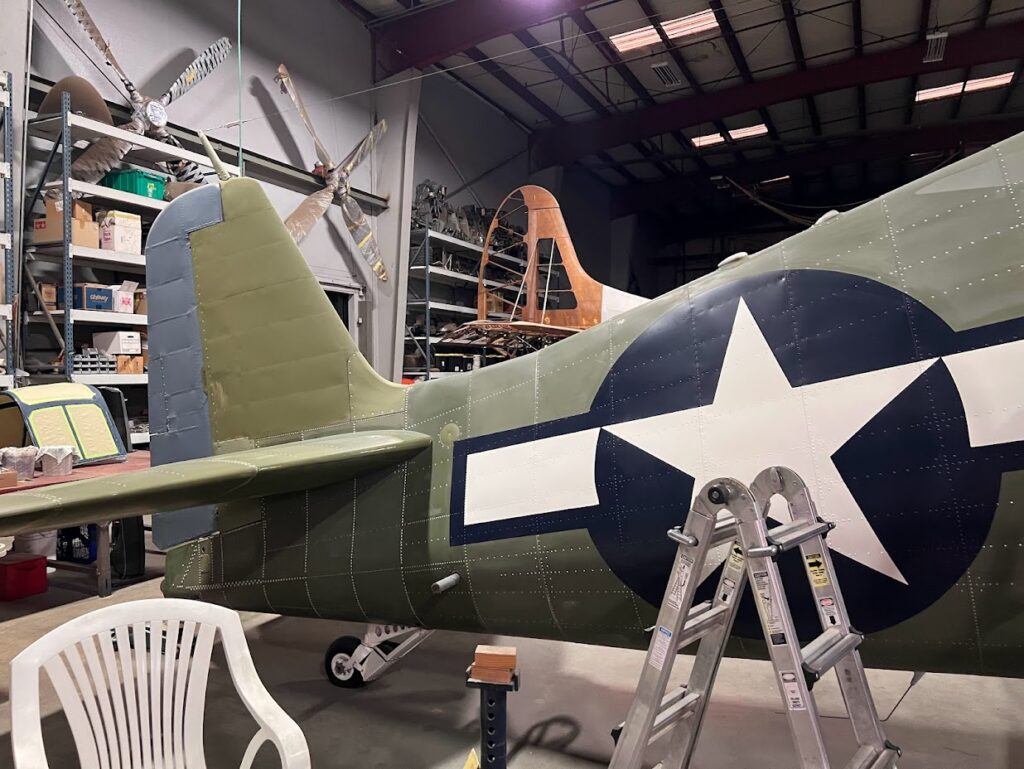
After returning to the Pacific following his period of leave (during which he also married his girlfriend, Kathryn Horn), Vraciu served aboard USS Enterprise (CV-6) with VF-20, in time to serve in the Philippine Campaign. Vraciu even survived being shot down over the Philippines on December 14, 1944 while strafing the Japanese-occupied airfield called Tala Field after strafing Clark Field and Angeles Field earlier that morning. Bailing out in the vicinity of an active volcano, Mount Pinatubo, Vraciu was met by Filipino guerilla fighters immediately after landing into the jungle with his parachute. He would spend five weeks fighting alongside the Filipino freedom fighters against the Japanese before returning to the air from USS Lexington. By war’s end, Vraciu was the U.S. Navy’s fourth leading ace, with a further 21 aircraft destroyed on the ground. With the end of WWII, Alexander Vraciu remained in the Navy as a test pilot and would help to establish the Naval and Marine Air Reserve program. From 1956 to 1958, Commander Vraciu served as the commanding officer of VF-51 and in 1957, he won the High Individual award for aerial gunnery at the Naval Air Weapons Meet at Naval Air Facility El Centro (later alternatively known as Vraciu Field). On December 31, 1963, Vraciu retired from the Navy while serving as the public information officer of NAS Alameda. After a second career with Wells Fargo in Danville, California and raising a family of five, Vraciu would spend his retirement years with his family, giving lectures about his WWII experiences and participating in oral history projects. Alexander Vraciu passed away in 2015 at the age of 96.
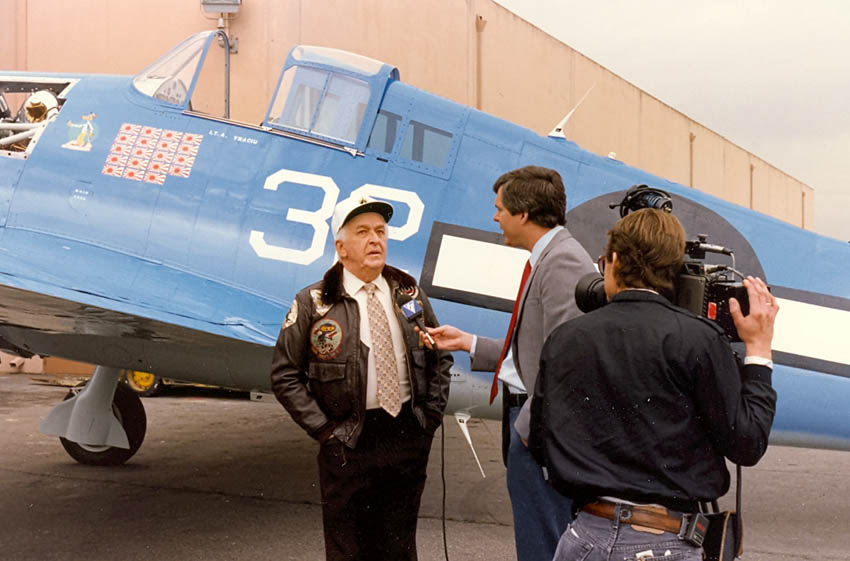
As F6F-5 Bu.80141 neared completion while in Royal Navy Fleet Air Arm colors in the summer of 1989, the aircraft was set to be sent to The Fighter Collection (TFC) in Duxford, England, with David Tallichet of Military Aircraft Restoration Corporation (MARC) and Steve Hinton of Fighter Rebuilders helping Stephen Grey of TFC bring the Hellcat to Duxford. Around this point, Stephen Grey and Steve Hinton reached out to Vraciu, who confirmed several details relating to the paint scheme of Bu.40467, and even lent Grey his original flying gloves to wear for the first post-restoration flight at Chino in July 1989. After its arrival in the United Kingdom, it was often claimed that F6F-5 80141, having been rebuilt using material from F6F-3 40467, was in fact the latter, and was thus Vraciu’s former aircraft. The issue of provenance persists even to this day as Texas-based collector and pilot Rod Lewis, having acquired 80141 from The Fighter Collection in 2015, is having the aircraft restored once more, this time with Ezell Aviation in Breckenridge, Texas, where it will fly once again in the near future.

Meanwhile, Yanks Air Museum would keep the remains of F6F-3s 08831 and 40467 to use for a restoration project of their own. Through the 2000s and the 2010s, the project progressed slowly but steadily, as the museum was also working on other projects, and sometimes work on the Hellcat was paused to complete these other restorations, such as two other WWII fighters now returned to active flight status (Yanks’ Curtiss P-40E Warhawk, which had served in the Royal Canadian Air Force as a Kittyhawk Mk.Ia, and their Bell P-63A Kingcobra known as Fatal Fang). It was also during the restoration of F6F-3 40467 that Yanks’ other Hellcat that was already on display (F6F-5 BuNo 76845) was sold to the Fagen Fighters WWII Museum in Granite Falls, Minnesota, after a restoration across Chino Airport at Fighter Rebuilders, 76845 would receive the name Death and Destruction, an homage to the Hellcat flown by U.S. Navy ace Don McPherson off USS Essex, and would win the Grand Champion for Warbirds Trophy at the 2021 EAA Airventure in Oshkosh, Wisconsin.
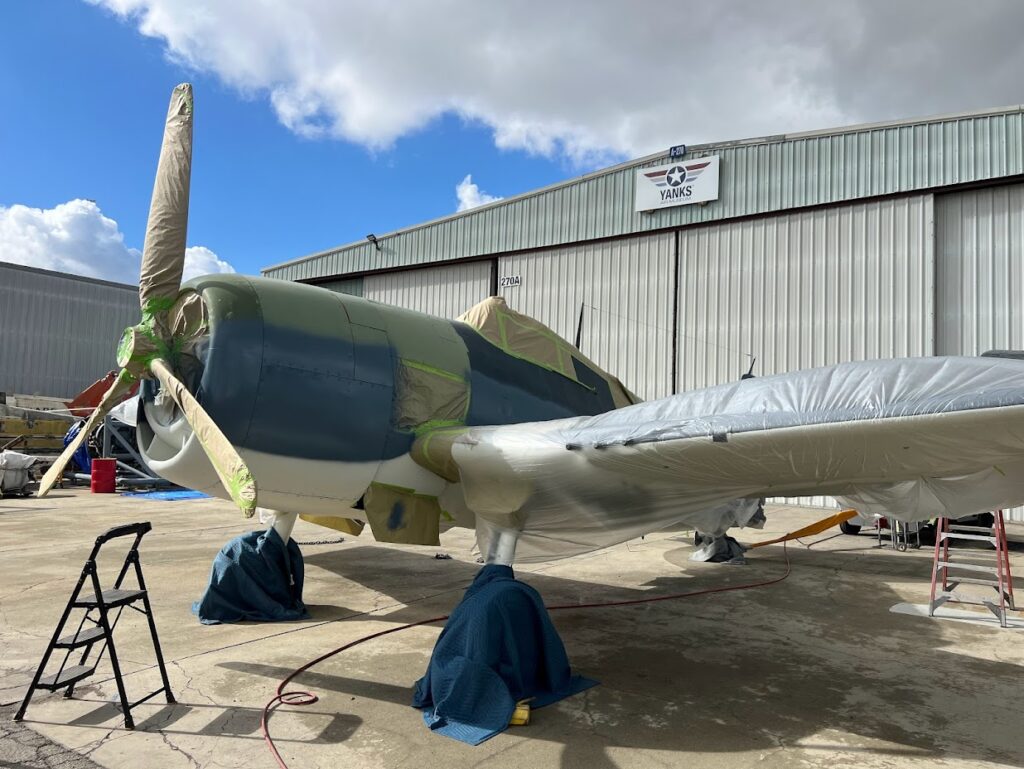
As the P-63 Fatal Fang was nearing its return to airworthiness, Yanks’ mechanics picked up steam on Vraciu’s Hellcat, and with Fatal Fang’s first flight on November 30th, 2023, F6F-3 40467 became the restoration shop’s primary target for the first half of 2024. As summer approaches, the museum is now preparing for the aircraft to make its first flight in eighty years, which may happen very soon!
The scheme now present on the Yanks Hellcat is accurate to how the aircraft appeared on the deck of the Intrepid from January through February 1944, based on historical photographs taken of the aircraft and to notes that Vraciu himself had written to various researchers in the warbird community. The aircraft’s squadron number 19 appears on both the left and right sides of the engine cowling, landing gear covers, fuselage center section and on the vertical stabilizer. The camouflage scheme is the standard Tri-Color scheme applied to U.S. Navy and U.S. Marine Corps aircraft from 1943 to 1944, consisting of Sea Blue, Intermediate Blue, and Insignia White. On the cockpit section, the stencil “LT. A. VRACIU” appears underneath the cockpit canopy frame, while the nine Japanese flags represent the aerial victories made by Vraciu up to February 1944. Two unit emblems are also present on the aircraft; the Felix the Cat emblem used by both VF-3 and VF-6 when the squadrons switched their codes when Vraciu was serving under O’Hare appeared on both sides of the cockpit section, while a snorting bull similar to the one adopted by the Army Air Force’s 13th Fighter Squadron and the name “Gadget” appear on the right hand-side.
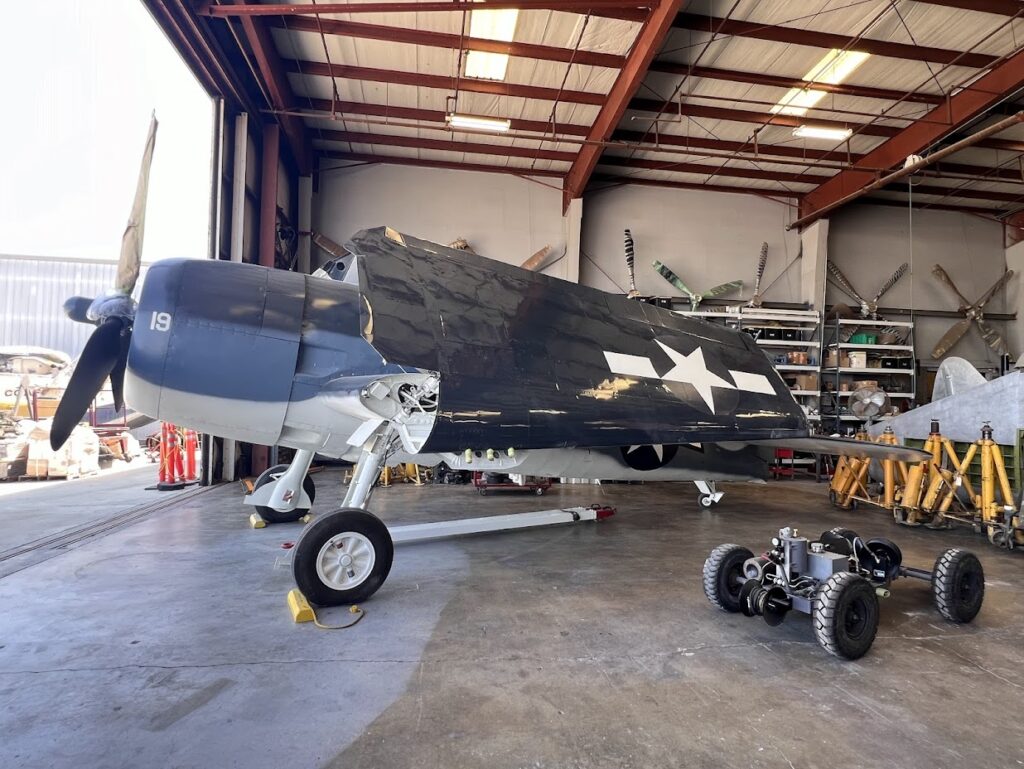
Time will tell soon enough when Vraciu’s Hellcat will be ready to take to the skies once again, but what is more certain is the fact that we at Vintage Aviation News will be closely following all developments relating to the Yanks Air Museum’s Hellcat.
Special thanks to the Yanks Air Museum for their cooperation and accommodation for the production of this article, and to Nick Veronico and Noah Stegman Rechlin for providing invaluable primary and secondary sources that helped to ensure the thoroughness and breadth of details in this article.







